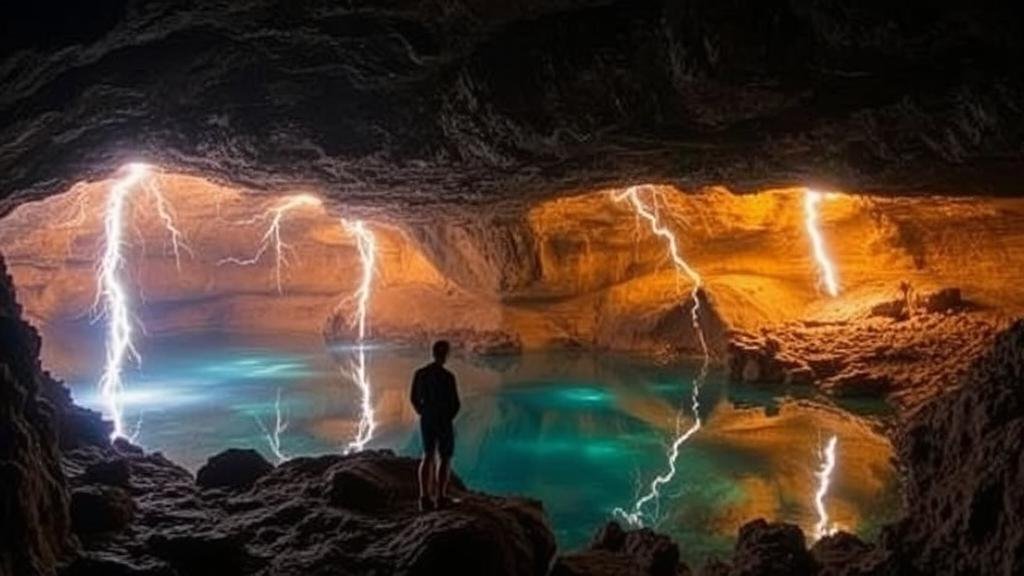Searching for the rumored “Cave of Eternal Thunder,” a cavern deep in South America where lightning strikes underground pools.
The Quest for the Cave of Eternal Thunder
Deep within the lush landscapes of South America lies a legend shrouded in mystery and intrigue–the Cave of Eternal Thunder. Rumored to be a cavern where lightning strikes underground pools, this mythical location has captivated explorers, scientists, and adventurers alike. With stories dating back centuries, the search for this elusive cave is steeped in both folklore and the promise of scientific discovery.
The Legend and Its Origins
The essence of the Cave of Eternal Thunder can be traced back to various indigenous cultures within the Amazon rainforest. Local tribes often speak of a cave that harnesses the power of the storm, turning lightning into an almost ethereal source of energy. This legend not only signifies the cultural relationship these indigenous people have with nature but also highlights their understanding of the natural phenomena surrounding them.
For example, the Yanomami tribe, whose territories span Brazil and Venezuela, has stories about a glowing cave rumored to be filled with pools that reflect flashes of lightning. Although the cave itself has not been conclusively found, these narratives have sparked immense interest throughout various fields, including geology, meteorology, and folklore research.
Scientific Context
Intrigued by the possibility of such a cave existing, scientists began to explore the electromagnetic fields generated by lightning and how they interact with geological formations. In fact, research conducted by the Earth Institute at Columbia University shows that lightning can indeed create unique environments through electrochemical reactions. These reactions can lead to the formation of certain minerals and compounds that potentially mimic the conditions described in the legends.
Lightning strikes approximately 1.6 billion times globally each year, creating impacts that can change the landscape and substrate it strikes. This finding suggests that the interfaces of water and rock could be transformed in ways that support the possibility of phenomena similar to that described in the Cave of Eternal Thunder.
Geographical Considerations
Much of the speculation regarding the caves location centers on the Amazon basin, particularly in remote areas accessible only through challenging terrain. Notable regions include:
- The Jungles of Roraima in Venezuela
- The Andes Mountains stretching through several countries, including Bolivia and Peru
- The Tepuis, or tabletop mountains, known for their unique geological features
These areas not only provide the right conditions for thunderstorms but also possess complex underground cave systems formed by ancient limestone dissolution processes. Evidence of lightning-induced formations could well exist in these challenging environments, complicating exploration efforts.
Modern Exploration Efforts
With advancements in technology, modern explorers have prioritized scientific expeditions into these uncharted territories. Expeditions utilize tools such as Geographic Information Systems (GIS) and LiDAR mapping, which can penetrate dense foliage and reveal geological features beneath the canopy.
In recent years, expeditions led by universities and research institutions have garnered media attention. 2020 expedition by the University of Amazonas aimed to study electromagnetic activity in the region in hopes of tracing the caves rumored location. While they did not find the cave, they collected valuable data that contributes to our understanding of the complex interactions between geological formations and atmospheric phenomena.
Challenges and Concerns
The search for the Cave of Eternal Thunder is not without its challenges. Explorers face numerous hazards, from treacherous terrain and rapid weather changes to encounters with wildlife and navigating the legal complexities of the regions protected indigenous lands. Also, the ecological impact of exploration raises ethical questions, highlighting the balance between exploration and conservation.
The Future of the Quest
While the Cave of Eternal Thunder remains undiscovered, the excitement surrounding its search continues to drive scientific inquiry and adventurous spirit. As environmental concerns become more paramount, understanding the relationship between geology and atmospheric phenomena is essential. The legend of the cave serves not only as an inspiration but a reminder of the unpredictable, yet awe-inspiring, forces of nature.
Conclusion
The journey in search of the Cave of Eternal Thunder symbolizes humanitys enduring desire to uncover the mysteries of our world. Whether this cave exists or is merely an embodiment of folklore, the quest for its discovery contributes significantly to scientific knowledge and cultural appreciation. Interested individuals can participate in conservation efforts, stay informed about ongoing research, and explore local histories that celebrate the connection between nature and humanity.



